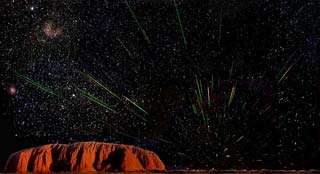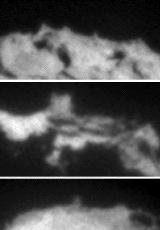
| Bad Astronomy |
|
|
|
BA Blog
|
|
Q & BA
|
|
Bulletin Board
|
| Media |
|
|
|
Bitesize Astronomy
|
|
Bad Astro Store
|
|
Mad Science
|
|
Fun Stuff
|
| Site Info |
|
|
|
Links
|
| RELATED SITES |
| - Universe Today |
| - APOD |
| - The Nine Planets |
| - Mystery Investigators |
| - Slacker Astronomy |
| - Skepticality |
Buy My Stuff

Keep Bad Astronomy close to your heart, and help make me
filthy rich. Hey, it's either this or one of those really
irritating PayPal donation buttons here.
James McCanney's Nonsense: Comets Gaining Mass
McCanney Claim #3: Comets do not lose mass, they gain mass as they near the Sun
This is the core of McCanney's theory. He calls it the "Plasma Discharge Comet Model". He says that comets are rocky, and that they interact with the solar wind. Because the solar wind is mostly protons, and therefore positive, comets break up what he calls "the solar capacitor". By doing this, the comets actually are attracting matter, drawing in mass.
There are several parts to this page. Although they are all short, I will make a quick list of links to them:
- The solar capacitor
- Observations of mass loss
- Meteor showers
- Cometary composition
- Surface structures
I show in another page that comets are not asteroidal, but cold and icy. I also show in another page that the solar wind is electrically neutral, and not positively charged. So we know going in that (you guessed it!) McCanney is wrong. But what does he mean when he talks about the "the solar capacitor"?
A capacitor is an electronic device that consists of positive and negative charges stored in different regions, usually metal plates separated by an insulating material. McCanney claims that the solar wind is positive, leaving the Sun to be negatively charged. This would naturally make the Sun a capacitor, since the solar wind keeps the charges separated.
But this is wrong, since the solar wind is neutral overall! So this part of McCanney's theory is wrong as well.
Ignoring the two fundamental problems with this theory (if you can!), what about comets gaining mass? Well, (wait for it)... McCanney is wrong here as well. There are several lines of evidence for this.
For one, we actually see material coming off comets! For example, the comet Hale-Bopp, an extremely bright and well-studied visitor back in 1997, gave off what looked like exanding spirals of material in what astronomers call a "garden-sprinkler" effect. The frozen nucleus of the comet rotates. As parts of the comet are exposed to the heat of the Sun, the material can go from solid directly to gas. Frozen gas can exist in pockets in the comet, so when these heat up they emit the gas in a jet-like plume. As the comet rotates, the plume moves out in arcs, lit by the Sun (you can read more about this in a webpage I wrote elsewhere on this site). There are even time-lapse animations of this clearly showing the material moving outward from the comet, not inward (CLICK THAT LINK! It's amazing). This is literally graphic proof that McCanney is wrong.
 Another line of evidence comes in the form of meteors.
Meteors, also called shooting stars, are bits of ice, rock, and dust
that burn up in our atmosphere (note: when out in space they
are called meteoroids, when burning up they are called
meteors, and when they hit the ground (if they do!) they
are called meteorites).
You can usually spot several meteors in a given night.
A meteor shower is a flurry of meteors that occur at about the
same time every year. The Leonids are the most famous,
occurring around November 12th every year. The Perseids are another,
occurring in August.
Another line of evidence comes in the form of meteors.
Meteors, also called shooting stars, are bits of ice, rock, and dust
that burn up in our atmosphere (note: when out in space they
are called meteoroids, when burning up they are called
meteors, and when they hit the ground (if they do!) they
are called meteorites).
You can usually spot several meteors in a given night.
A meteor shower is a flurry of meteors that occur at about the
same time every year. The Leonids are the most famous,
occurring around November 12th every year. The Perseids are another,
occurring in August.
Why are they a regular, annual event? It's because meteoroids orbit the Sun in streams. They fill their orbit with particles as opposed to, say, a planet which orbits the Sun all in one piece. If that meteroid orbit intersects the Earth, then the Earth will crash headlong into them like a car driving through a swarm of gnats (ewwww). The Earth would hit that part of the meteoroid orbit every year at the same time, and that's why we get meteor showers around the same date every year.
So where do these streams come from? Well, remember that meteors are bits of ice and rock. Sound familiar? Yes, comets are made of the same thing. In the standard (that is, correct) theory, comets are made of dust and rocks bound together by ice. As a comet nears the Sun, the ice melts (more properly, it turns directly to a gas) and the ice and rock can slough off. Like a litterbug tossing empty soda cups out the window of his car, a comet leaves behind a trail of pebbles, rocks, and ice chunks.
This is not just some wild idea; it's verified. The Leonid meteor shower, for example, is well-known to be detritus from the comet Tempel-Tuttle. The orbits of the meteroids match that of the comet very well. In fact, the orbits of the meteoroids are so well-understood that astronomers can even predict when we intersect dense regions of the stream, resulting in meteor storms. Even the number of meteors seen can be accurately predicted. It's a triumph of mainstream science.
If McCanney were right, we wouldn't see meteor showers! Comets would be attracting matter, not shedding it.
There's more to the meteoroid story, too. Meteors are known to be made of the same material as comets (using spectroscopy, the same tool used to get comet temperatures). The solar wind is completely unlike comet material; it's mostly hydrogen. Comets are made of ices, and have lots of complex molecules in them. So McCanney has to resort to a different source for the matter falling onto a comet. In his book, he says (page 69) that there are pockets of this material floating around in the solar system, attracted to comets by their overpowering electromagnetic force.
This is a ridiculous assertion. That much material lying around inside the solar system-- enough, according to McCanney, to make a planet-- would be so thick it would be incredibly obvious to any astronomer trying to peer through it. It would be like a fog, dimming the light of the stars beyond. Perhaps McCanney might imagine a NASA conspiracy to hide this information, but any astronomer, anywhere in the world, would notice it. In fact, it would have easily been discovered a century ago! How big does a conspiracy have to be to hide all this data that is so obvious to McCanney?
What's obvious is how wrong McCanney is.
 If all that's not enough for you (and it should be!), there is yet
more. Another argument against comets accreting matter came from
close-ups taken by
the Stardust spacecraft. When
it passed the comet Wild 2 in June, 2004, it took many
images of the nucleus. In some images there are
tall, narrow objects about a hundred meters tall. These appear
to be spires. It's possible that the spires are erosional features,
like mesas on Earth.
If you have a hard material surrounded
by softer stuff, and the softer stuff erodes away (through outgassing),
you are left with a tall column of the harder material.
So these are not unexpected if comets are
outgassing material.
If all that's not enough for you (and it should be!), there is yet
more. Another argument against comets accreting matter came from
close-ups taken by
the Stardust spacecraft. When
it passed the comet Wild 2 in June, 2004, it took many
images of the nucleus. In some images there are
tall, narrow objects about a hundred meters tall. These appear
to be spires. It's possible that the spires are erosional features,
like mesas on Earth.
If you have a hard material surrounded
by softer stuff, and the softer stuff erodes away (through outgassing),
you are left with a tall column of the harder material.
So these are not unexpected if comets are
outgassing material.
But they are completely unexpected if the comet is drawing in material. I would even say impossible. Material coming in at several kilometers per second would smash the spires. The dust would sandblast the surface down to a smooth ball. The fact that there are features at all on the surface of a comet argues against McCanney's theories.
Conclusion: comets do not gain mass, they shed mass. We have direct observations of this material loss, and we know it forms meteoroid streams and tall surface features. McCanney is wrong.
|
|
|
|